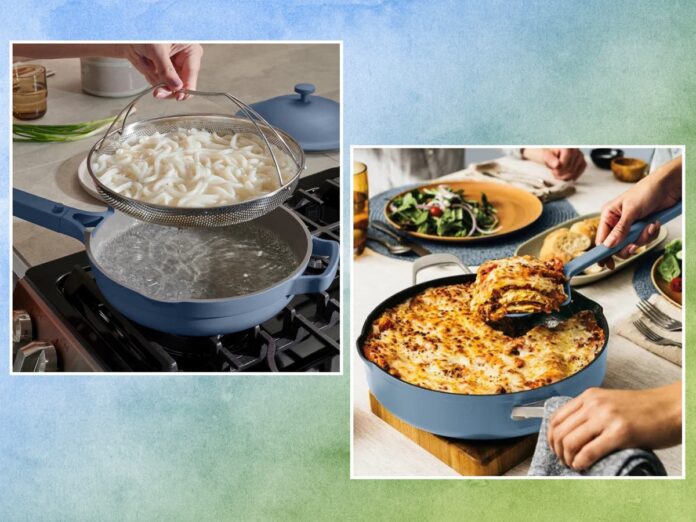There’s no denying the always pan 2.0 is beautiful, with a matte design like something you might find in a gallery rather than something you would use to fry an egg. This 2.0 iteration is made from 100 per cent post-consumer recycled aluminum, too. Like the possible pan, it’s deep enough to boil a hefty portion of pasta, plus you can use the strainer to steam, and strain pasta straight from the pan (more on that later). It’s also now oven-safe up to 230C – unlike the original model – so, we baked breaded cauliflower, roasted miso aubergine, and turned our cheesy tomato pasta into a crispy pasta bake without reaching for a seperate baking dish. Read more: Best non-stick frying pans One of the major differences between the two pans is size. The possible pan has a 3.8l capacity, which makes it the bigger beast of the two, while the always pan (2.46l) is better suited to smaller spaces and cooking for one. What’s more, when you compare with the strainers and lids included, it’s much lighter and easier to manoeuvre around the kitchen with one hand. Using oil should help with maintaining the ceramic non-stick coating, and we found that a spoonful really helps the non-stickiness, with food slipping around the pan as if on a layer of air but, even without oil, our pancakes and tofu didn’t end up cemented to the pan. There was some sticking and residue left on the pan when cooking with high heats, though. Some users of the original always pan have complained the non-stick surface becomes less effective over time, but Our Place claims the new coating on the 2.0 will last 50 per cent longer. We can’t confirm this just yet, as we haven’t used the pan for long enough to notice any change in the effectiveness of the non-stick coating. Read more: Russell Hobbs’s air fry mini oven review One thing we did find frustrating was the recommendation to avoid metal utensils and cook with low to medium heat, to protect the non-stick coating. If you only enjoy the occasional pan sear, though, Our Place does say that using high heat every now and again shouldn’t be cause for concern. There’s also plenty to be said for its practicality. The rounded shape of the pan fits the curve of the spatula well, which made it easy to scrape and stir around as we cooked, while sauce and porridge was easy to serve from the pan’s tapered pour spouts, which double as steam vents while cooking. The lid and the angular pan handle are easy to grasp but beware when holding the handle near to the pan bowl as this does get hot. We did also think it was slightly strange that the small handle on the other side of the pan isn’t heat proof. But, the notch on the handle for nestling the spatula in between stirs is genius for preventing pasta sauce splotches on the countertop. Read more: Best blenders for super-quick smoothies We weren’t convinced by the functionality of boiling with the colander inside the pan, which is a criticism that applies to both pans, as you still then have a dripping colander and a pan full of water to deal with. But it’s helpful for pouring plain pasta straight onto your plate, and we did really like using it as a steamer. One minor annoyance is that the basket needs to be lifted with gloves or the spatula (slightly precarious), as its metal handles are inside the pan and will be hot. However, we really like the beechwood spatula, which, despite not being dishwasher-proof, was easy enough to clean with soap and water. And, really, one less plastic thing in the world is no bad thing. The same goes for the pan itself – it can’t go in the dishwasher, but even charred remains and next-day pasta sauce simply melt away with some warm soapy water.
Our Place vs Ninja: Which all-in-one cookware is worth your money?
Sourceindependent.co.uk
RELATED ARTICLES


